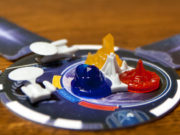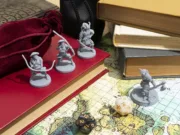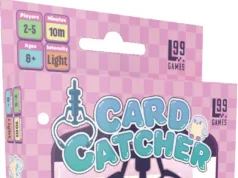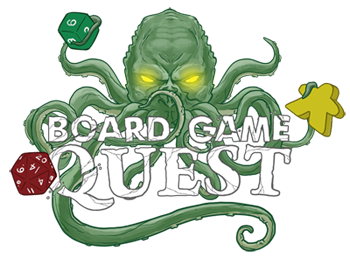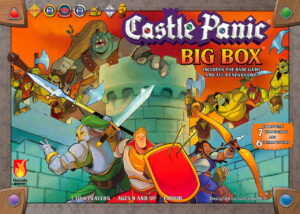 Sometimes when assignments come across Board Game Quest Overlord Tony Mastrangeli’s desk, he benevolently hands them out to the staff. “I know you really like games with tracks so I set this aside for you,” a yellow Post-it will read when a box appears neatly placed on my desk. Or sometimes a new children’s game will appear in my cubby in the breakroom with two smiley face stickers for my kids. It’s moments like this when I’m glad to be a part of the BGQ team.
Sometimes when assignments come across Board Game Quest Overlord Tony Mastrangeli’s desk, he benevolently hands them out to the staff. “I know you really like games with tracks so I set this aside for you,” a yellow Post-it will read when a box appears neatly placed on my desk. Or sometimes a new children’s game will appear in my cubby in the breakroom with two smiley face stickers for my kids. It’s moments like this when I’m glad to be a part of the BGQ team.
And then there are the times when the other, crueler Tony emerges. Like the other day when a box was placed on the floor near the entrance to my cubicle—a trip hazard to be sure. The note on top of it was scrawled in a chaotic, Hyde-not-Jekyll cursive: “You’re the most panicky person I know so get this review done.”
Harsh, and truer than I’d like to admit, this is how the assignment to review the Castle Panic Big Box came to be under my purview. The game is designed by Justin De Witt and plays 1-6 players in around 45 minutes.
Gameplay Overview:
Castle Panic is a cooperative tower defense game in which players will use card actions to attack advancing enemies who spawn on a circular grid around their castle. The castle is protected by walls and towers and (in the basic version of the game) players lose if all of the towers are destroyed before they win.
The players’ turns are fairly simple, consisting of drawing and playing cards (and potentially swapping cards with their teammates). Any number of cards can be played and the actions are all straightforward (most are in the vein of “hit an enemy in this colored space or zone”). Some of the cards trigger other powers and—when adding in the expansions—these can range from simple to slightly complex.

After a player has finished their turn, all the monsters on the board advance one space closer to the castle and then new monsters are added to the board. These spawn at the furthest point away from the castle and the zone is selected via die roll. Most of these monsters are just standard creatures with a set hit-point value, while others have powers that usually impact all the monsters on the board in some way. (They might all recover health, for example, or move one zone clockwise.) Occasionally, instead of a monster players will encounter an action token from the bag and these will impact the board in a variety of ways. (Moving all monsters in a specific zone, for instance.)
If a monster ever hits a castle wall, it destroys it (and takes damage), leaving your towers vulnerable to attack. One inside the walls, monsters will spin around the interior of the castle, taking out your towers one by one, assuming they have enough health left to spend.
Play continues like this until either the players lose their castle, or they survive the onslaught by eliminating every monster from the bag and on the board.
The Big Box I’m reviewing also includes promos and four full expansions, which can be mixed and matched in any combination. (Including playing everything everywhere all at once—see below for my thoughts on that.) Since Tony Mastrangeli told me to conserve ink for the review (he growled this to me; something about “words ain’t free”), I won’t be going into great detail about every rule these expansions add.
Here’s the tl;dr for each:
Engines of War introduces resources that build weapons players can use. The Dark Titan adds more powerful enemies and the Cavalier figure who helps players. The Wizard’s Tower adds a special tower that allows players to use powerful spells. Crowns and Quests introduce unique player powers and Quests that alter the endgame conditions.

Game Experience:
I’ve never played vanilla Castle Panic before so this is in effect a full review of the game itself and not just the Big Box treatment. (Disclaimer: I did actually own a spinoff game called Dead Panic, which no one has ever heard of. It features a similar grid advancing concept but had some of the most irritating “zombies move based on noise” rules I’ve ever encountered.) Right off the bat, I’ll say that I understand why this game has endured for as long as it has. The base game is pretty simple and turns move quickly. It also looks really cool on the table and there is a solid feeling of impending doom as the monsters advance toward an open chasm in your team’s wall.
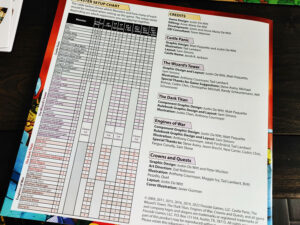
The expansions also add a ton of variety to the game. And I do mean a ton. I wouldn’t recommend adding everything in as doing so turns a light-ish game into a slog of flipping through a rulebook to understand edge case after edge case. (I did try this “all-in” version because that’s the mission I was assigned. There’s this helpful and incredibly large chart on the back of the rulebook to help with setup with adding everything in. I appreciate the effort to include it, but it hurts my brain just thinking about it.)
Big Boxes are designed for this type of endeavor, however, and having everything in one place does allow players to customize their game however they like. I have my preferred setup (Base+Wizard’s Tower+Character Powers+Quests) and would likely ignore everything else on repeat plays.
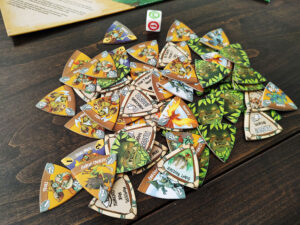
The game moves incredibly fast (only undermined by its somewhat lengthy setup if playing with an expansion or two), but also has a solid overall length; it never feels too long or too short, thereby avoiding the “we lost immediately” problems that coop games sometimes have.
All that being said, Castle Panic feels like a relic from another time. (And not just because of its vague medieval theme.) It’s still fun and I imagine this has a place in the gaming libraries of many, but it does feel dated in its basic mechanics. Coop games like The LOOP have taken these threat-mitigation games to different places and while the expansions included in the Big Box do help complicate the main game, it all feels very tacked on even if you use some of the more advanced variants (say, the missions) as a starting point.
Final Thoughts:
I don’t think there’s a lot to say negatively about Castle Panic. The closest I can come to a “negative” is that the game was designed so long ago it feels a bit dated, but that’s hardly the fault of the designer. The base Castle Panic game is a light and breezy, albeit still tense, coop with limited replay value. The expansions are successful to varying degrees, with some changing the end-game conditions (that’s good!) and others adding extra phases that occur in between the normal phases of the game and can be difficult to track (that’s bad!). The game is also way too bloated if playing the “full game” and, while I imagine most people wouldn’t even consider that as an option, I don’t think the game itself requires that much variability. (The base game doesn’t have enough variety and tends to play itself and the expansions add a whole bunch of confusing stuff that isn’t always rewarding.)
Final Score: 3 Stars. A throwback coop game that is fun and has lots of “Big Box” stuff even though it doesn’t quite fit among more-modern games of its ilk.
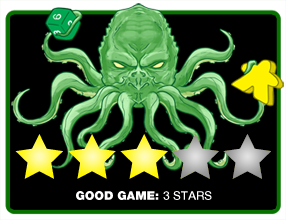 Hits:
Hits:
• Solid organization solution
• Comes with a ton of stuff
• Mostly intuitive gameplay
• Expansions add replay value
Misses:
• Rulebook is difficult to navigate when using multiple expansions
• Setup is a bit of a chore
• Games tend to feel “samey” after a time (even with expansions mixed in)
• Feels dated



